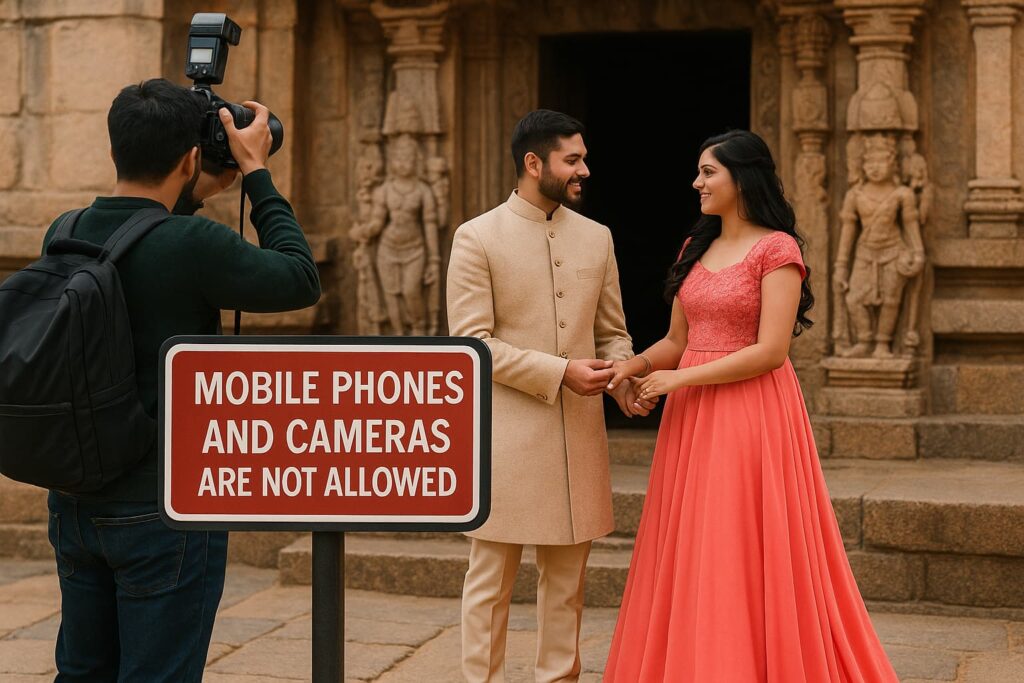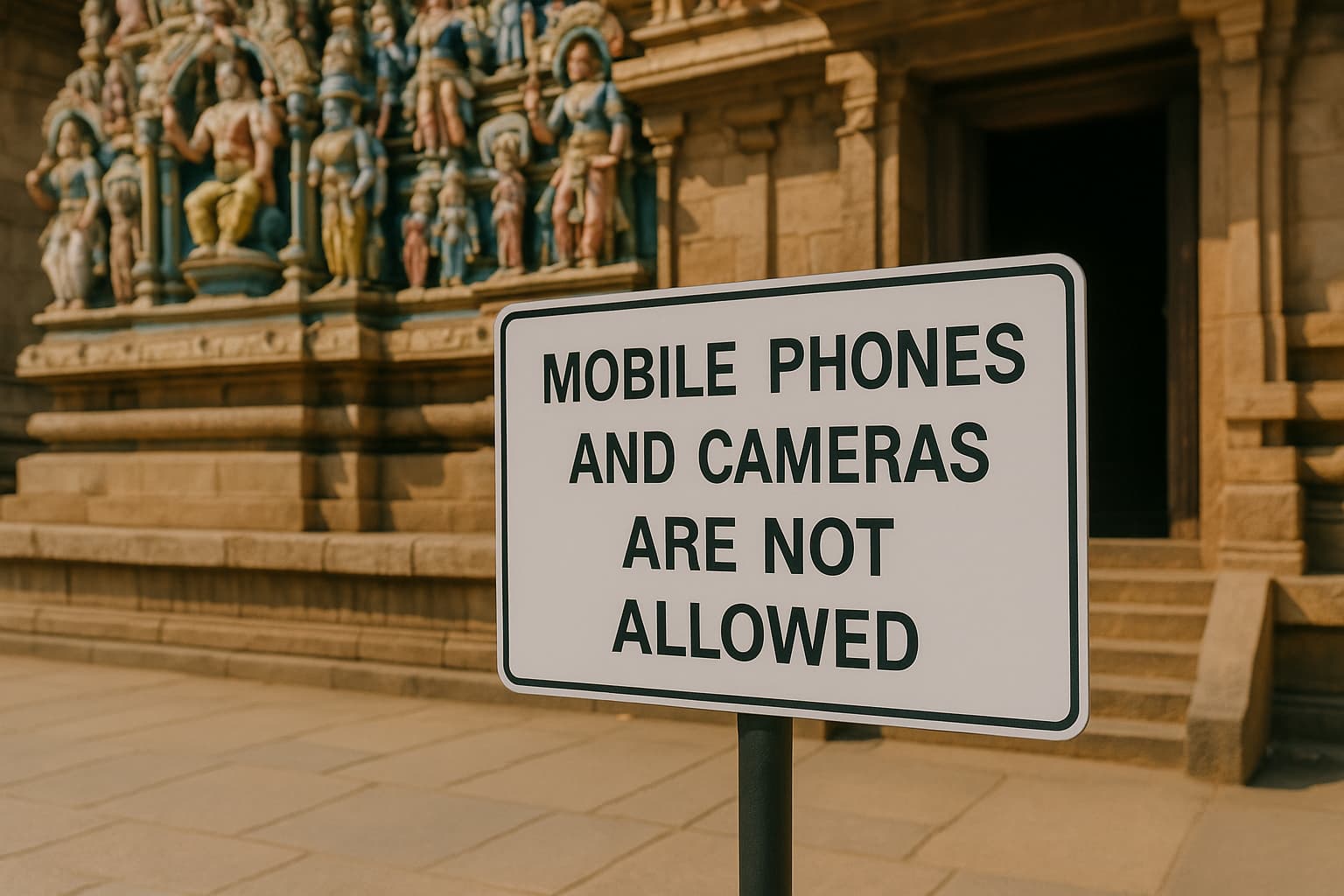Why mobile phones are not allowed in temples is a question many modern devotees and travelers often ask. In today’s hyper-connected world, our phones travel with us from bedrooms to boardrooms — and sometimes, even to places they shouldn’t. One such sacred space is the temple.
Across India — especially in culturally rich states like Karnataka, Tamil Nadu, Kerala, and Odisha — countless temples have implemented strict “no phone, no camera” policies. Whether it’s a quiet shrine in a village or a grand pilgrimage site, these rules aren’t just about tradition — they serve deeper purposes tied to spirituality, discipline, and security.
So, what’s behind this digital restriction in sacred spaces?
Let’s explore the practical, cultural, and spiritual reasons behind this decision — supported by real examples, temple protocols, and visitor tips.
🕊️ Preserving Peace and Spiritual Atmosphere
Temples are built to offer more than just architecture or rituals — they are spaces for inner stillness and sacred connection. Unlike crowded tourist spots or public gatherings, the atmosphere in a temple is meant to be calm, focused, and spiritually uplifting. Mobile phones and cameras often interfere with this purpose in subtle but powerful ways.
Here’s how they disturb the peace:
🔕 Unwanted noise: Ringtones, message alerts, or accidental videos can disturb quiet meditation and chanting.
🤳 Selfie distractions: People pausing for selfies or videos draw attention away from the sanctity of the space.
🔦 Flash lighting: Sudden camera flashes can startle devotees and affect traditional rituals.
📱 Interrupting rituals: Receiving calls or messages during an aarti or pooja creates disrespectful interruptions.
🙇 Loss of presence: When people are focused on recording, they’re no longer fully present in the spiritual moment.
➡️ Local Example: In Chamundeshwari Temple (Mysuru) and Murudeshwar Temple (Uttara Kannada), signage clearly requests devotees to switch off mobile phones near the sanctum. This isn’t just a rule — it’s a reminder to protect the temple’s natural tranquility.
📌 Smart Temple Etiquette: What to Do Before Taking Your Phone Inside
| 📱 Tip | 📝 What You Should Do |
|---|---|
| 📴 Keep Your Phone Silent or Off | Avoid disturbances during aarti or meditation. Prefer basic phones if needed. |
| 🧳 Use Locker Facilities | Most major temples offer lockers near entrances. Carry small change if lockers are paid. |
| ❓ Ask If You’re Not Sure | Always check with temple staff or signage for phone and photography rules. |
| 📸 Respect Sacred Zones | If allowed, take photos only in open areas like the gopuram or outer corridors, not near the sanctum. |
| 👨👩👧 Don’t Record Others | Avoid filming or photographing other devotees without permission — especially during personal rituals. |
| 🚫 Avoid Drones & Tripods | Unless you have special permission, never use drones or bulky video gear inside temple premises. |
| 🕊️ Focus on the Experience | Temples are meant for presence, not performance. Keep your device away and mind in the moment. |
🔒 Security Concerns: From Ancient Gold to Government Protocols
While temples are spiritual places, many also act as repositories of wealth, heritage, and high-value assets. Some temples hold large quantities of gold, ancient jewelry, and historical documents — making them sensitive zones that require strict surveillance.
Allowing mobile phones and cameras can pose serious security risks, both digital and physical. That’s why many temples enforce tech restrictions, not just for spiritual reasons, but for protection and privacy too.
🛑 Why Phones & Cameras Are a Security Risk:
🧧 Temple treasures at risk: Some temples store centuries-old gold, silver, and ornaments, making them potential targets for criminals.
🔍 Surveillance loopholes: Visitors filming temple interiors can unintentionally expose layouts, entrances, and security points.
🛰️ Drone misuse: Flying drones without permission near temples can violate airspace norms and capture restricted areas.
👀 Leaked rituals: Some rituals are meant to be sacred and private. Recording them may lead to misuse or viral circulation without context.
📥 Unauthorized uploads: Even a small photo can end up online, misused by someone, or spark unnecessary controversies.
➡️ Local Example: The Padmanabhaswamy Temple in Kerala, considered one of the richest temples in the world, enforces military-grade security. Mobile phones and cameras are strictly banned even near its outer gates. Similarly, many ancient temples in coastal Karnataka have increased tech restrictions after recent security evaluations.
👉 Read our other article on temple mysteries: Karnataka’s unexplained shrines that continue to defy logic.
📷 Respecting Tradition and Cultural Sensitivity
Temples are not just physical structures — they represent centuries of tradition, culture, and belief systems. Many rituals, idols, and sacred spaces inside temples follow customs passed down through generations. Using mobile phones or cameras in these spaces often goes against those cultural boundaries.
In many regions, photographing deities, priests, or rituals is not only discouraged — it’s considered deeply disrespectful. That’s why temple authorities ban mobile usage to protect the sanctity of sacred practices and maintain the traditional decorum of the space.
🎎 How Phone Usage Violates Temple Traditions:
📸 Photographing idols is forbidden in many traditions, especially inside the garbhagriha (inner sanctum).
🙅 Not all moments are meant to be captured — some poojas are private, involving family vows or personal grief.
🎥 Pre-wedding shoots and reels have turned spiritual spaces into cinematic sets, disturbing rituals and devotees.
📷 Heavy DSLR or videography setups are often restricted due to space, distraction, and misuse concerns.
🛑 Drone filming over temple complexes is usually prohibited without official permission and may breach religious guidelines.
➡️ Local Insight: In temples like Dharmasthala (Dakshina Kannada) and Sringeri Sharada Peetham, capturing photos of deities is considered inappropriate and strictly disallowed. Even professional media requires prior permission to document rituals or festivals.
🪔 Managing Crowds and Preventing Chaos
Temples, especially during weekends, festivals, or special rituals, often witness large gatherings of devotees. In such situations, even a small distraction — like someone stopping for a selfie or recording a video — can lead to disruption, delay, or even conflict in the darshan flow.
Banning mobile phones and cameras helps temple authorities manage crowd movement, maintain discipline, and ensure that everyone gets a peaceful darshan experience — without bottlenecks caused by digital distractions.
🚶 How Mobile Use Creates Chaos in Temples:
🧍♀️ Devotees stop to take selfies or group photos, slowing down queues in narrow temple corridors.
🪔 During aarti or special pooja, mobile flashes or live streaming disrupt the priest and distract other devotees.
📵 People answering calls loudly inside sanctums creates unnecessary noise and tension.
🚧 Phone use near fire lamps, oil lamps, or crowded corners increases the risk of minor accidents.
👮♂️ Managing tech use drains temple volunteers’ energy, who are already handling crowd control duties.
➡️ Local Note: During Mangaluru Dasara and annual fairs at temples like Kateel Durgaparameshwari, temple authorities deploy staff specifically to prevent phone use. This isn’t to annoy visitors — it’s to keep the spiritual experience smooth and uninterrupted for thousands.
🏛️ Protecting Ancient Architecture
Many temples in India are not only spiritual landmarks but also living museums of ancient art, sculpture, and design. From delicate carvings to hand-painted ceilings and century-old wooden beams — these structures are vulnerable to both time and technology.
Even something as simple as flash photography or excessive foot traffic driven by camera use can cause long-term damage. That’s why many temples ban photography altogether — not out of secrecy, but to preserve the artistic heritage for future generations.
🧱 How Phones and Cameras Can Harm Temple Architecture:
💡 Flashlight exposure can damage ancient paintings and natural color pigments on temple walls.
🚷 Increased crowding near intricate carvings (due to people trying to get perfect angles) leads to wear and accidental damage.
🏗️ Vibrations from heavy camera gear or tripod setups can disturb old flooring and stone placement.
🧽 Touching old sculptures for selfies contributes to erosion of soft stone detailing.
📸 Unauthorized viral videos often attract tourist crowds for all the wrong reasons — not devotion, but content.
➡️ Local Highlight: At the Chennakeshava Temple in Belur and Hoysaleswara Temple in Halebidu, the Hoysala carvings are so intricate that even the smallest crack can ruin an entire story etched in stone. Flash photography is discouraged to protect their fading brilliance.

🚫 Rising Misuse: Pre-Wedding Shoots, Drones & Heavy Equipment
Temples have increasingly become backdrops for aesthetic photography and cinematic shoots — from pre-wedding videos to social media reels. While creativity is welcome in many places, using sacred spaces for flashy content often crosses the line between admiration and misuse.
What begins as “just one shot” can lead to disruption of rituals, crowd discomfort, and disrespect toward the space’s sanctity. That’s why many temples now ban not just phones, but also DSLRs, drones, tripods, and commercial filming without special permission.
🎬 How Modern Content Creation Misuses Temple Space:
💍 Pre-wedding and influencer shoots turn temple courtyards into photo studios, interrupting rituals and foot traffic.
🎥 Heavy cameras, lighting gear, and tripods create obstructions and distract priests and devotees.
🚁 Drones flying over temple towers (gopurams) can breach privacy and airspace laws, especially during festivals.
🎦 Unapproved filming of private rituals may later go viral without context, hurting sentiments or spreading misinformation.
📣 Loud direction calls (“Ready? Action!”) destroy the meditative mood and silence of the temple premises.
➡️ Local Insight: In Hampi and Shravanabelagola, drone usage is completely banned near temple zones. In South Canara, many temples like Kudroli Gokarnanatha now require written approval for even basic video coverage to avoid disrespect or crowding.
📵 Temples in India Where Mobile Phones Are Strictly Prohibited
| Temple Name | Location | Why Phones Are Banned |
|---|---|---|
| Padmanabhaswamy Temple | Thiruvananthapuram, Kerala | High-security area with ancient treasures and restricted sanctum access. |
| Meenakshi Amman Temple | Madurai, Tamil Nadu | To preserve spiritual ambiance and avoid misuse of deity images. |
| Jagannath Temple | Puri, Odisha | Strict ban on phones, leather items, and photography to respect sanctity. |
| Tirumala Venkateswara Temple | Tirupati, Andhra Pradesh | Phones not allowed beyond checkpoints due to crowd and ritual discipline. |
| Golden Temple (Harmandir Sahib) | Amritsar, Punjab | Phones allowed outside, strictly prohibited near the sanctum and during prayers. |
| Kashi Vishwanath Temple | Varanasi, Uttar Pradesh | No electronics allowed; complete locker system for tight security. |
| Dharmasthala Manjunatha Temple | Dakshina Kannada, Karnataka | Strict phone and camera ban near sanctum and pooja areas. |
| Shringeri Sharada Peetham | Chikkamagaluru, Karnataka | To maintain traditional silence and avoid distractions during Vedantic rituals. |
🙏 A Matter of Personal Privacy Too
Not every temple visit is about celebration or ceremony. For many, it’s a deeply personal journey — a moment of silence, a prayer for healing, or the fulfillment of a private vow. In such moments, being photographed or filmed without consent can feel intrusive and disrespectful.
Temples protect not just the sanctity of rituals, but also the dignity of the devotee. That’s why many temple authorities encourage visitors to leave their phones outside, creating a safe and sacred space for everyone to reflect, express, or grieve — without fear of going viral.
🧍 Why Respecting Devotees’ Privacy Matters:
😔 People visit temples to pray, cry, or make personal offerings — not to become part of someone else’s content.
✂️ Capturing someone mid-ritual without permission is a breach of both faith and privacy.
🪮 Tonsure ceremonies (head shaving), charity rituals, and special vows are intimate moments not meant for public sharing.
🤳 Recording others unknowingly, especially women, children, or elderly devotees, is a growing concern in crowded temples.
📵 Phone-free zones help everyone feel present and protected, especially during sensitive rituals.
➡️ Local Context: In temples like Kukke Subramanya and Kateel Durgaparameshwari, people undergo tonsure or special vows — these moments are emotionally intense and highly personal. That’s why photography is discouraged inside ritual halls or near special pooja areas.
🔚 Final Thought: Honor the Silence, Embrace the Sacred
In a world where screens demand our constant attention, temples invite us to pause — to breathe, reflect, and reconnect with something deeper than notifications. These are not just buildings of stone and sculpture; they are spaces carefully preserved for inner stillness and timeless tradition.
While technology connects us to the world, temples connect us to the soul. For just a short while, leaving our devices behind isn’t a restriction — it’s a release.
Let’s respect these sacred spaces — not just because rules tell us to, but because the peace they protect is more valuable than any photo we might take.
👉 Learn more: Read about the customs and significance of Hindu weddings on Wikipedia.
📵 FAQs – Mobile Phones in Temples
Phones are restricted to maintain spiritual focus, prevent noise, and protect temple sanctity.
Q2. Can I take photos inside temples?
Most temples prohibit photography inside sanctums. Always follow posted rules or ask staff.
Q3. What happens if I bring a mobile to the temple?
Some temples provide lockers. Others may deny entry or ask you to switch off your phone.
Q4. Are there temples where phones are allowed?
Yes, some modern temples allow silent mode use, but photography is usually still banned.

